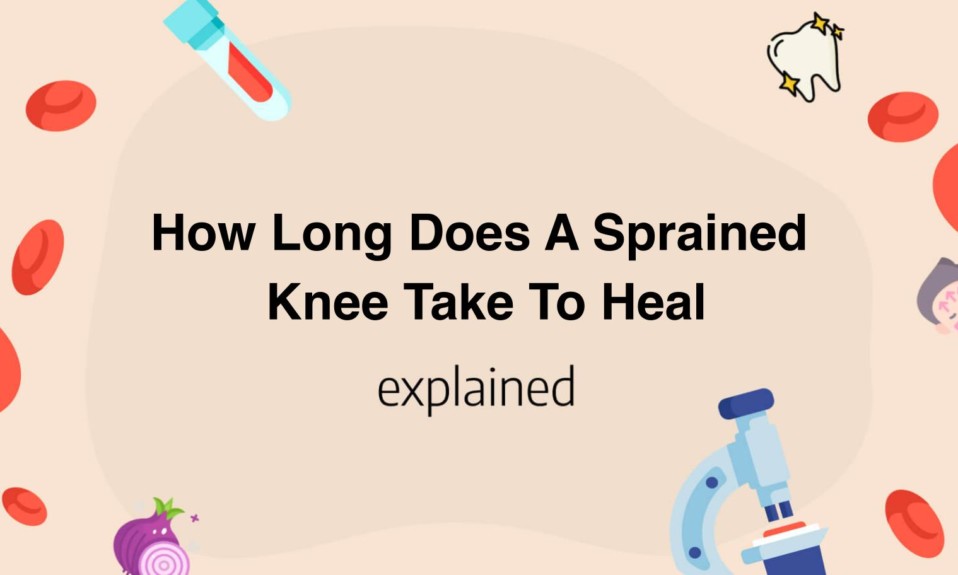Sprained knee is a common injury that can happen to anyone, from athletes to regular people engaged in physical activities.
It occurs when there is a partial or complete tear of ligaments in the knee joint, leading to pain and discomfort.
The recovery period for a sprained knee varies depending on the severity of the injury.
Typically, mild or moderate sprains can take up to 3-6 weeks or longer to heal, while severe sprains may require several months of rehabilitation.
In this article, we will explore the factors that affect the healing process and what you can do to speed up recovery.
- A sprained knee is an injury that affects ligaments and can lead to pain, swelling, and limited movement.
- The healing time for a sprained knee can vary depending on the severity of the injury and the treatment given.
- In general, a mild sprain can take 1-2 weeks to heal, while a moderate sprain can take 4-6 weeks.
- For severe sprains, the healing process can take several months and may require surgery.
- It is important to rest, ice, compress and elevate the affected knee to facilitate healing and prevent further damage.
Importance of timely treatment for knee sprains
Knee sprains are a common injury among athletes and individuals who engage in physical activity.
Although it is tempting to push through the pain, it is crucial to seek timely treatment to alleviate pain, prevent further injury, and avoid long-term complications.
Prompt medical attention can help minimize inflammation and aid in the healing process.
Delaying treatment can make the injury even worse, leading to chronic pain, stiffness, or even instability in the knee joint.
There are several methods of treatment that can help to speed up the recovery process, such as resting the affected knee, applying ice to the area, and using compression wraps.
In more severe cases, physical therapy may be required to regain strength and mobility, while surgery may be necessary in the most extreme cases.
Early diagnosis and treatment greatly increase the chances of a full recovery and the ability to resume normal activities.
Ignoring a knee sprain may seem like a minor issue, but over time, the damage can become more significant, leading to long-term consequences.
For example, untreated knee sprains can potentially cause osteoarthritis, which is a chronic condition that causes pain and inflammation in the joints.
Additionally, untreated injuries can affect an individual’s quality of life, leading to limited mobility and difficulty performing everyday tasks.
It is essential to be cautious and pay attention to any signs of discomfort or pain in the knees.
Taking proactive steps, such as performing proper warm-ups, using appropriate gear, and seeking treatment if needed, can help prevent knee injuries from occurring in the first place.
Ensuring that you are taking the necessary steps to care for your joint health can improve your overall well-being, allowing you to engage in physical activities without worry or fear of injury.
In conclusion, timely treatment for knee sprains is crucial to prevent further injury and long-term complications.
Seeking medical attention as soon as possible, resting the affected area, and utilizing appropriate treatment methods can enhance the healing process and increase the chances of a full recovery.
Remember to listen to your body, take the necessary precautions, and seek medical attention promptly when needed to optimize your joint health.
Common causes of knee sprains in athletes
Athletes are prone to knee sprains as a result of sudden twisting, awkward movements, or direct impact.
Overuse of the knee joint can also lead to this injury.
Repetitive flexing and extension of the knee joint, combined with forceful movements, can cause damage to the ligaments that hold the joint together.
This is particularly true for athletes whose sports require running, jumping, or quick changes in direction, such as soccer, basketball, and tennis players.
Another common cause of knee sprains is improper technique or training.
Incorrectly landing from a jump or not following proper form while lifting weights can result in an injury.
In addition to these factors, poor nutrition, dehydration, and fatigue can also increase an athlete’s risk of experiencing a knee sprain.
To prevent knee sprains, athletes should start with warm-up exercises to prepare their body for the physical activity ahead.
By gradually increasing their heart rate and circulation, this can prepare the muscles and ligaments to handle the impact of their sport.
Wearing proper equipment and choosing appropriate footwear is also essential.
Athletes should opt for shoes that have good traction, support, and cushioning designed specifically for their sport.
Strengthening exercises should also be added to their regular workout routine.
This can help build stronger muscles which in turn stabilize the knee joint and lessen the chances of injuries.
Consulting with a physical therapist or trainer will help athletes learn proper techniques and form specific to their sport, reducing the risk of improper movements that could lead to a knee sprain.
In conclusion, knee sprains can happen to any athlete but can often be prevented by proper preparation and avoiding risky movements.
Athletes should stay hydrated, practice proper form, wear appropriate footwear, and consider a comprehensive nutrition plan that supports their physical demands.
They should also listen to their body and not push too hard to avoid fatigue, as this can increase the risk of injury.
By taking these preventative measures, athletes can lower their risk of a debilitating knee sprain and continue to enjoy their sport without interruptions.
Types of knee sprains and severity levels
There are three types of knee sprains: medial collateral ligament (MCL) sprain, lateral collateral ligament (LCL) sprain, and anterior cruciate ligament (ACL) sprain.
MCL sprains occur when there is excessive force on the outside of the knee that causes the MCL to stretch or tear.
This is the most common type of knee sprain and is often caused by contact sports such as football or soccer.
LCL sprains, on the other hand, occur when there is excess force on the inside of the knee, causing the LCL to stretch or tear.
This type of sprain is less common and often occurs during skiing, football, or soccer.
Lastly, ACL sprains happen when an excessive force causes the ACL to stretch or tear.
This is the most severe type of knee sprain and often occurs during sports that require sudden changes in direction, such as basketball or football.
Knee sprains can also be categorized into three levels of severity: Grade 1, Grade 2, and Grade
- A Grade 1 sprain is considered mild and involves the ligament being stretched but not torn.This type of sprain can usually be treated at home with rest, ice, compression, and elevation.
- A Grade 2 sprain is considered moderate and involves a partial tear of the ligament.
This type of sprain may require physical therapy or the use of crutches for a period of time.
- Lastly, a Grade 3 sprain is considered severe and involves a complete tear of the ligament.
This type of sprain often requires surgery and a significant amount of rehabilitation to regain strength and mobility in the knee.
It’s important to note that knee sprains can happen to anyone, not just athletes.
In fact, older adults are at a higher risk of spraining their knee due to weakened ligaments and muscles.
If you experience pain, swelling, or stiffness in your knee after an injury, it’s important to seek medical attention to determine the severity of the sprain and the best course of treatment.
In the meantime, rest and ice can help to alleviate pain and reduce inflammation.
Symptoms to watch out for when dealing with a knee sprain
When it comes to knee sprains, there are several symptoms to watch out for.
Pain is a common one and can range from mild to severe depending on the extent of the injury.
Swelling and bruising are also signs of a sprained knee, as our body’s natural response to damage is to send fluid and blood to the affected area.
Difficulty walking or bearing weight on the injured leg is another crucial symptom.
If you cannot put weight on the affected leg, you may have a more severe sprain or other injury that requires medical attention.
In addition to pain and swelling, there may also be a loss of range of motion in the knee joint.
This can make it difficult to bend or straighten the leg, and may also manifest as a feeling of stiffness when you try to move your knee.
You may also experience popping or clicking sounds in your knee as you move, which can be an indication of damage to the ligaments or other structures in the joint.
If you’re experiencing any of these symptoms after injuring your knee, it’s important to take proper precautions to avoid further damage.
Resting the injured leg, using ice, compression, and elevation techniques, and avoiding activities that could aggravate the injury are all important steps in recovery.
If your symptoms persist or worsen over time, or if you experience severe pain or a sudden inability to put weight on your leg, you should seek medical attention right away.
By watching out for these symptoms and taking proper care of your injured knee, you can increase your chances of a full and speedy recovery.
Read also: Pansinusitis: Definition, Causes and Treatment
How Long Does A Sprained Knee Take To Heal
A sprained knee can cause excruciating pain and limping, making it difficult to carry out daily activities.
Recovery time can vary depending on the severity of the sprain.
Generally, a mild to moderate sprain will take around 2-4 weeks to heal, while a severe sprain can take up to a few months of careful treatment.
Rest, ice, compression, and elevation (RICE) therapy is the most common method used to treat a sprained knee, which entails immobilizing the knee with the help of a bandage or brace.
Icing the affected area for 20-30 minutes, thrice a day, can also help reduce swelling and inflammation.
Anti-inflammatory medication can assist in minimizing pain while reducing inflammation.
It is crucial for patients to allow ample rest and avoid putting pressure on the knee until it’s fully healed.
In addition to RICE therapy, physical therapy is also essential in the recovery process.
It is vital for patients to work with a certified physical therapist and follow their customized therapy routines to strengthen the muscles surrounding the knee and restore the knee’s stability.
A proper physical therapy routine can help prevent future injuries and improve mobility.
Using supportive devices like crutches or a cane may be necessary for patients who have difficulty bearing weight on the affected leg.
Even though it is essential to allow the time needed to heal fully, being sedentary can lead to muscle atrophy, which can further delay the healing process.
Gentle exercise can help in the healing process by increasing blood flow and oxygen to the knee.
Low-impact exercises like swimming, cycling, or using an elliptical machine are preferable during the initial phases of recovery.
In conclusion, a sprained knee requires a delicate balance of rest and active treatment.
Depending on the severity of the sprain, it may take anywhere from a few weeks to months to heal fully.
Patients must follow their doctor’s guidance and complete customized physical therapy routines, and avoid putting too much weight on the knee before it has fully recovered.
Read also: How Long Can You Live With Neuropathy
Top treatment options for knee sprains
Knee sprains can be quite debilitating, and if left untreated, they can lead to chronic pain and knee instability.
Fortunately, there are a number of treatment options available that can help to alleviate the pain and promote healing.
One of the most effective treatments for knee sprains is rest and ice therapy.
This involves resting the affected knee, avoiding any physical activity that may exacerbate the injury, and applying ice packs to the affected area for 15-20 minutes at a time, several times a day.
This helps to reduce swelling and inflammation and can promote the healing process.
Another effective treatment option for knee sprains is compression therapy.
This involves wrapping the affected knee in a compression bandage to help reduce swelling and provide support to the joint.
When it comes to allopathic treatment, physiotherapy can be helpful in the case of knee sprains.
Physiotherapists can provide specific exercises that can help to strengthen the muscles surrounding the knee, which can provide additional support and stability to the joint.
Additionally, anti-inflammatory medications such as ibuprofen or naproxen can help to alleviate pain and swelling associated with knee sprains.
In more severe cases, medical professionals may recommend using a brace or even surgery to treat the affected knee.
For people who prefer natural treatments, acupuncture or chiropractic care can be helpful in treating knee sprains.
Acupuncture involves inserting thin needles into specific points on the body to promote healing and balance, while chiropractic care involves manipulating the spine and joints to alleviate pain and promote healing.
Additionally, herbal remedies such as turmeric or ginger can help to reduce inflammation and promote healing.
In conclusion, there are many treatment options available for knee sprains.
From rest and ice therapy to acupuncture and herbal remedies, each treatment has its own unique benefits and can be tailored to meet the needs of the individual.
If you are experiencing knee pain or have recently suffered a knee sprain, it is important to consult a medical professional to determine the best course of treatment for your particular situation.
Read also:










